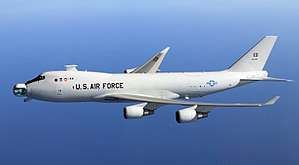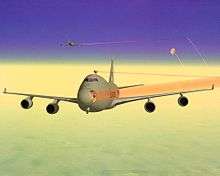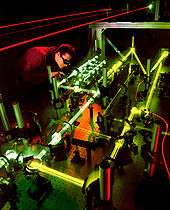Boeing YAL-1
The Boeing YAL-1 Airborne Laser Testbed (formerly Airborne Laser) weapons system was a megawatt-class chemical oxygen iodine laser (COIL) mounted inside a modified military aircraft same as the Boeing 747-400F. It was primarily designed as a missile defense system to destroy tactical ballistic missiles (TBMs) while in boost phase. The aircraft was designated YAL-1A in 2004 by the U.S. Department of Defense.[1]
| YAL-1 Airborne Laser | |
|---|---|
 | |
| ABL aircraft during flight | |
| Role | Airborne Laser (ABL) anti-ballistic missile weapons system |
| Manufacturer | Boeing |
| First flight | July 18, 2002 |
| Retired | September 25, 2014 |
| Status | Canceled |
| Primary user | United States Air Force |
| Number built | 1 |
| Developed from | Boeing 747-400F |
| Career | |
| Serial | 00-0001 |
The YAL-1 with a low-power laser was test-fired in flight at an airborne target in 2007.[2] A high-energy laser was used to intercept a test target in January 2010,[3] and the following month, successfully destroyed two test missiles.[4] Funding for the program was cut in 2010 and the program was canceled in December 2011.[5] It made its final flight on February 14, 2011 to Davis–Monthan Air Force Base in Tucson, Arizona to be kept in storage at the "Boneyard" by the 309th Aerospace Maintenance and Regeneration Group. It was ultimately scrapped in September 2014 after all usable parts were removed.
Development
Origins


The Airborne Laser Laboratory was a less-powerful prototype installed in a Boeing NKC-135A. It shot down several missiles in tests conducted in the 1980s.[6]
The Airborne Laser program was initiated by the US Air Force in 1996 with the awarding of a product definition risk reduction contract to Boeing's ABL team.[7][8] In 2001, the program was transferred to the MDA and converted to an acquisition program.[8]
The development of the system was being accomplished by a team of contractors. Boeing Defense, Space & Security provides the aircraft, the management team and the systems integration processes. Northrop Grumman was supplying the COIL, and Lockheed Martin was supplying the nose turret and the fire control system.[8][9]
In 2001, a retired Air India 747-200 was acquired by the Air Force, and trucked without its wings from the Mojave Airport to Edwards Air Force Base where the airframe was incorporated into the System Integration Laboratory (SIL) building at Edwards' Birk Flight Test Center, to be used to fit check and test the various components.[10][11] The SIL was built primarily to test the COIL at a simulated operational altitude, and during that phase of the program, the laser was operated over 50 times, achieving lasing durations representative of actual operational engagements. These tests fully qualified the system so that it could be integrated into the actual aircraft. Following the completion of the tests, the laboratory was dismantled, and the 747-200 fuselage was removed.[11]
Boeing completed initial modifications to a new 747-400F off the production line in 2002, culminating in its first flight on July 18, 2002 from Boeing's Wichita, Kansas facility. Ground testing of the COIL resulted in its successful firing in 2004. The YAL-1 was assigned to the 417th Flight Test Squadron Airborne Laser Combined Test Force at Edwards AFB.
Testing
Besides the COIL, the system also included two kilowatt-class Target Illuminator Lasers for target tracking. On March 15, 2007, the YAL-1 successfully fired this laser in flight, hitting its target. The target was an NC-135E Big Crow test aircraft that has been specially modified with a "signboard" target on its fuselage. The test validated the system's ability to track an airborne target and measure and compensate for atmospheric distortion.[9]
The next phase in the test program involved the "surrogate high-energy laser" (SHEL), a stand-in for the COIL, and demonstrated the transition from target illumination to simulated weapons firing. The COIL system was installed in the aircraft and was undergoing ground testing by July 2008.[12]
In an April 6, 2009 press conference, the Secretary of Defense Robert Gates recommended the cancellation of the planned second ABL aircraft and said that the program should return to a Research and Development effort. "The ABL program has significant affordability and technology problems and the program's proposed operational role is highly questionable," Gates said in making the recommendation.[13]
There was a test launch off the California coast on June 6, 2009.[14] At that time it was anticipated that the new Airborne Laser Aircraft could be ready for operation by 2013 after a successful test. On August 13, 2009 the first in-flight test of the YAL-1 culminated with a successful firing of the SHEL at an instrumented test missile.[15]
The U.S. Missile Defense Agency (MDA) on August 18, 2009 successfully fired the high-energy laser aboard the aircraft in flight for the first time. The YAL-1 took off from Edwards Air Force Base and fired its high-energy laser while flying over the California High Desert. The laser was fired into an onboard calorimeter, which captured the beam and measured its power.[16]
In January 2010, the high-energy laser was used in-flight to intercept, although not destroy, a test Missile Alternative Range Target Instrument (MARTI) in the boost phase of flight.[3] On February 11, 2010 in a test at Point Mugu Naval Air Warfare Center-Weapons Division Sea Range off the central California coast, the system successfully destroyed a liquid-fuel boosting ballistic missile. Less than an hour after that first missile had been destroyed, a second missile—a solid-fuel design—had, as announced by the MDA, been "successfully engaged", but not destroyed, and that all test criteria had been met. The MDA announcement also noted that ABL had destroyed an identical solid-fuel missile in flight eight days earlier.[17] This test was the first time that a directed-energy system destroyed a ballistic missile in any phase of flight. It was later reported that the first February 11 engagement required 50% less dwell time than expected to destroy the missile, the second engagement on the solid-fuel missile, less than an hour later, had to be cut short before it could be destroyed because of a "beam misalignment" problem.[18][19]
Cancellation
Secretary of Defense Gates summarized fundamental concerns with the practicality of the program concept:
"I don't know anybody at the Department of Defense, Mr. Tiahrt, who thinks that this program should, or would, ever be operationally deployed. The reality is that you would need a laser something like 20 to 30 times more powerful than the chemical laser in the plane right now to be able to get any distance from the launch site to fire ... So, right now the ABL would have to orbit inside the borders of Iran in order to be able to try and use its laser to shoot down that missile in the boost phase. And if you were to operationalize this you would be looking at 10 to 20 747s, at a billion and a half dollars apiece, and $100 million a year to operate. And there's nobody in uniform that I know who believes that this is a workable concept."[20]
The Air Force did not request further funds for the Airborne Laser for 2010; Air Force Chief of Staff Schwartz has said that the system "does not reflect something that is operationally viable".[21][22]
In December 2011, it was reported that the project was to be ended after 16 years of development and a cost of over US$5 billion.[23][24] While in its current form, a relatively low power laser mounted on an unprotected airliner may not be a practical or defensible weapon, the YAL-1 testbed is considered to have proven that air mounted energy weapons with increased range and power could be another viable way of destroying otherwise very difficult to intercept sub-orbital ballistic missiles and rockets. On 12 February 2012, the YAL-1 flew its final flight and landed at Davis-Monthan AFB, Arizona, where it was placed in storage at the AMARG until it was ultimately scrapped in September 2014 after all usable parts were removed.[25][26]
As of 2013, studies were underway to apply the lessons of the YAL-1 by mounting laser anti-missile defenses on unmanned combat aerial vehicles that could fly above the altitude limits of the converted jetliner.[27]
By 2015, the Missile Defense Agency had started efforts to deploy a laser on a high-altitude UAV. Rather than a manned jetliner containing chemical fuels flying at 40,000 feet (12 km), firing a megawatt laser from a range of "tens of kilometers" at a boost-phase missile, the new concept envisioned an unmanned aircraft carrying an electric laser flying at 65,000 feet (20 km), firing the same power level at targets potentially up to "hundreds of kilometers" away for survivability against air defenses. While the ABL's laser required 55 kg (121 lb) to generate one kW, the MDA wanted to reduce that to 2–5 kg (4.4–11.0 lb) per kW, totaling 5,000 lb (2,300 kg) for a megawatt. Unlike the ABL, which required its crew to rest and chemical fuel to be reloaded, an electric laser would need only power generating from fuel to fire, so a UAV with in-flight refueling could have near-inexhaustible endurance and armament. A "low-power demonstrator" has been planned to fly sometime in or around 2021.[28]
Boeing's Jim Albaugh sees it as a pretty good deterrent for the North Korean missile program if it was operational.[29]
Design

COIL
The heart of the system was the COIL, comprising six interconnected modules, each as large as an SUV. Each module weighed about 6,500 pounds (3,000 kg). When fired, the laser produced enough energy in a five-second burst to power a typical American household for more than an hour.[9]
Use against ICBMs vs TBMs

The ABL was designed for use against tactical ballistic missiles (TBMs). These have a shorter range and fly more slowly than ICBMs. The MDA has recently suggested the ABL might be used against ICBMs during their boost phase. This could require much longer flights to get in position, and might not be possible without flying over hostile territory. Liquid-fueled ICBMs, which have thinner skins, and remain in boost phase longer than TBMs, might be easier to destroy.
If the ABL had achieved its design goals, it could have destroyed liquid-fueled ICBMs up to 600 km away. Tougher solid-fueled ICBM destruction range would likely have been limited to 300 km, too short to be useful in many scenarios, according to a 2003 report by the American Physical Society on National Missile Defense.[30]
Intercept sequence
The ABL system used infrared sensors for initial missile detection. After initial detection, three low power tracking lasers calculated missile course, speed, aimpoint, and air turbulence. Air turbulence deflects and distorts lasers. The ABL adaptive optics use the turbulence measurement to compensate for atmospheric errors. The main laser, located in a turret on the aircraft nose, could be fired for 3 to 5 seconds, causing the missile to break up in flight near the launch area. The ABL was not designed to intercept TBMs in the terminal, or descending, flight phase. Thus, the ABL would have had to be within a few hundred kilometers of the missile launch point. All of this would have occurred in approximately 8 to 12 seconds.[31]
Operational considerations

The ABL did not burn through or disintegrate its target. It heated the missile skin, weakening it, causing failure from high speed flight stress. The laser used chemical fuel similar to rocket propellant to generate the high laser power. Plans called for each 747 to carry enough laser fuel for about 20 shots, or perhaps as many as 40 low-power shots against fragile TBMs. To refuel the laser, YAL-1 would have to land. The aircraft itself could have been refueled in flight, which would have enabled it to stay aloft for long periods. Preliminary operational plans called for the ABL to be escorted by fighters and possibly electronic warfare aircraft. The ABL aircraft would likely have had to orbit near potential launch sites (located in hostile countries) for long periods, flying a figure-eight pattern that allows the aircraft to keep the laser aimed toward the missiles.[32]
Use against other targets
In theory, an airborne laser could be used against hostile fighter aircraft, cruise missiles, or even low-earth-orbit satellites (see anti-satellite weapon). However, the YAL-1 infrared target acquisition system was designed to detect the hot exhaust of TBMs in boost phase. Satellites and other aircraft have a much lower heat signature, making them more difficult to detect. Aside from the difficulty of acquiring and tracking a different kind of target, ground targets such as armored vehicles and possibly even aircraft are not fragile enough to be damaged by a megawatt-class laser.
An analysis by the Union of Concerned Scientists discusses potential airborne laser use against low earth orbit satellites.[33] Another program, the Advanced Tactical Laser, envisions air-to-ground use of a megawatt-class laser mounted on an aircraft better suited for low altitude flight.
Operators
Specifications
Data from
General characteristics
- Crew: 6
- Length: 231 ft 8 in (70.6 m)
- Wingspan: 211 ft 3 in (64.4 m)
- Height: 63 ft 8 in (19.4 m)
- Airfoil: root: BAC 463 to BAC 468; tip: BAC 469 to BAC 474[34]
- Max takeoff weight: 875,000 lb (396,893 kg)
- Powerplant: 4 × General Electric CF6-80C2B5F turbofan engines, 62,000 lbf (276 kN) thrust each
Performance
- Maximum speed: 547.5 kn (630.1 mph, 1,014.0 km/h) at 35,000 ft (11,000 m)
- Cruise speed: 499.5 kn (574.8 mph, 925.1 km/h) at 35,000 ft (11,000 m)
Armament
- 1 × COIL
Avionics
- 1 × ABL infrared detector system
- 2 × Target Illuminator lasers
See also
Related development
Aircraft of comparable role, configuration and era
Related lists
References
- "DoD 4120.15-L, Model Designation of Military Aerospace Vehicles" (PDF). U.S Department of Defense. May 12, 2004.
- "Airborne Laser returns for more testing". Air Force. Archived from the original on March 8, 2007.
- "Airborne Laser Test Bed Media Gallery". www.mda.mil.
- Wolf, Jim; Alexander, David (February 12, 2010). "U.S. successfully tests airborne laser on missile". reuters.com. Reuters.
- "Boeing YAL-1 Airborne Laser impacted by Pentagon spending priorities". Flight Image of the Day. Archived from the original on October 20, 2013.
- "Airborne Laser Laboratory". globalsecurity.org.
- "Airborne Laser:News". Archived from the original on July 22, 2010. Retrieved June 20, 2006.
- "Airborne Laser Background presentation" (PDF). boeing.com. Archived from the original (PDF) on February 24, 2007.
- Grill, Tech. Sgt. Eric M. (March 21, 2007). "Airborne Laser fires tracking laser, hits target". Air Force. Archived from the original on December 11, 2008.
- Radecki, Alan K. (2005). A Mojave Scrapbook. Mojave Books.
- Hernandez, Jason (March 29, 2007). "Testers end high-energy laser tests, dismantle Airborne Laser SIL facility". USAF press release. Archived from the original on January 7, 2008.
- "'Laser jumbo' testing moves ahead". bbc.co.uk. BBC News. July 29, 2008. Archived from the original on April 14, 2019. Retrieved June 17, 2019.
- "Local News – Boeing "hit harder" than rivals by defense budget cuts – Seattle Times Newspaper". nwsource.com. Archived from the original on April 10, 2009.
- "Home Security Systems : My Home Security". globalsecuritynewswire.org.
- "Boeing Airborne Laser Team Completes 1st Airborne Test Against Instrumented Target Missile". mediaroom.com (Press release). Edwards Air Force Base, California: The Boeing Company. August 13, 2009. Retrieved June 17, 2019.
- "Boeing: Boeing Airborne Laser Team Fires High-Energy Laser in Flight". mediaroom.com (Press release). Edwards Air Force Base, California: The Boeing Company. August 20, 2009. Retrieved June 17, 2019.
- "Airborne Laser Testbed Successful in Lethal Intercept Experiment". U.S. Department of Defense Missile Defense Agency. February 11, 2010. Archived from the original on February 15, 2010.
- Butler, Amy (March 19, 2010). "Next ABL Test To Require Twice as Much Range". Aviation Week Intelligence Network. Aviation Week & Space Technology. Retrieved June 17, 2019 – via aviationweek.com.
- Aviation Week & Space Technology, February 22, 2010, p. 26.
- "Missile Defense Umbrella?". Center for Strategic and International Studies. Archived from the original on January 11, 2011.
- "Schwartz: Get those AF boots off the ground". airforcetimes.com.
- Hodge, Nathan (February 11, 2011). "Pentagon Loses War To Zap Airborne Laser From Budget". The Wall Street Journal.
- Butler, Amy (December 21, 2011). "Lights Out For The Airborne Laser". Aerospace Daily & Defense Report. Aviation Week & Space Technology. Archived from the original on July 28, 2012 – via aviationweek.com.
- Butler, Amy (December 20, 2011). "Lights Out For The Airborne Laser". Aerospace Daily & Defense Report. Aviation Week & Space Technology. Retrieved June 17, 2019 – via aviationweek.com.
- Nogee, Allen (May 6, 2014). "The Death of A Giant Laser". www.strategies-u.com. Strategies Unlimited. Retrieved June 17, 2019.
- "Google Maps".
- "MDA Eyes UAVs For Discrimination, Boost-Phase Kill". aviationweek.com.
- Return Of The ABL? Missile Defense Agency Works On Laser Drone - Breakingdefense.com, 17 August 2015.
- Albaugh, James (December 4, 2017). "Opinion: Jim Albaugh's Lessons Of Aerospace Success". aviationweek.com. Aviation Week & Space Technology. Retrieved June 17, 2019.
- "APS Study". aps.org. Archived from the original on February 13, 2007.
- "How Does it work - Airborne Laser". www.airborne-laser.com.
- Congress (2011). Congressional Record. Government Printing Office. ISBN 9780160924286.
- Wright, David; Grego, Laura (December 9, 2002). "Anti-Satellite Capabilities of Planned US Missile Defense Systems". ucsusa.org. Union of Concerned Scientists. Archived from the original on December 11, 2005.
- Lednicer, David. "The Incomplete Guide to Airfoil Usage". m-selig.ae.illinois.edu. Retrieved April 16, 2019.
External links
| Wikimedia Commons has media related to YAL-1 Airborne Laser. |
- Laser test – video footage
- YAL-1 ABL page
- Site dedicated to the Airborne laser
- An animation depicting the laser interception of a ballistic missile. (AVI format)
- Boeing's Compact Laser Weapon System